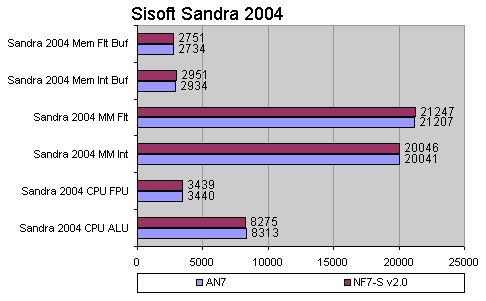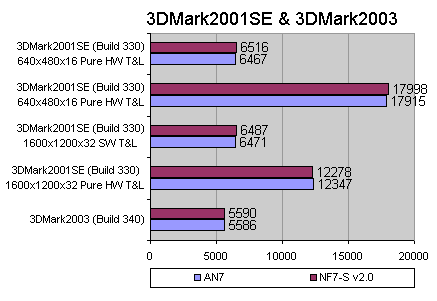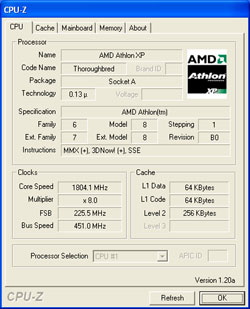|
|
Advertisement:
|
|
ABIT AN7 |
|
Join the community - in the OCAU Forums!
|
Performance, Overclocking and Conclusions
Performance:
ABIT's NF7-S v2.0 is an immensely popular socketA motherboard and widely regarded as one of the flagship nForce 2 solutions. Given that this new AN7 is heavily based on the NF7-S v2.0, we would expect it to perform at least on par with the older board.


As expected there is no difference between the two boards at the same settings. The tested components were an AthlonXP 2400+ running at 200x11 (2200MHz core speed), with a Powercolor Radeon 9800 Pro video card and two sticks of PC3500 in Dual-Channel mode at 400MHz DDR and CAS 2.5. Western Digital's WD1200JB 120GB ATA100 HDD and an Antec TruePower 550W PSU rounded out both testbeds.
Overclocking:
As expected from ABIT there are a huge number of tweaking and overclocking options in the BIOS. I spent a couple of hours messing around with the AthlonXP 2400+ and a DLT3C 1800+. The DLT3C's are the old king of socketA overclocking, with the focus more recently having passed on to the Barton-cored 2500+'s.
I stuck to using the SoftMenu III overclocking options in the BIOS. I did have a play with the OC Guru software in Windows but I found I could get better results in the BIOS. Interestingly, there's the note "Press F8 for automatic overclocking" in the BIOS. I duly pressed F8, then agreed to the prompt asking me if I was sure, which promptly dropped me back to the menu. It did that in two different BIOS versions, so I don't know what the story is with that feature.
The availability of multipliers seems to be a hit-and-miss affair on socketA, with various CPU and motherboard combinations allowing different multiplier options. I found with the latest BIOS I could get some quite low multipliers on my 1800+. 8X seemed a good setting with plenty of headroom, so up went the FSB. The maximum FSB I could get stably from the board was 225MHz. This is not too shabby at all for a stock motherboard, with the stock air-cooler on the NorthBridge and no cooling at all on the SouthBridge. The SB was in fact too hot to touch at 225MHz. I didn't test the sound, but there are a few reports of crackly onboard sound with too-hot SouthBridge chips, so you may want to slap an aftermarket cooler on there. A common mod on the NF7-S is to put the stock NorthBridge cooler on the SouthBridge and put something more exotic on the NorthBridge. Anyway, at 230MHz the system would fail to boot but at 225MHz it seemed stable enough, running 3DMark2003, cleanly booting and shutting down etc. Here's a screenshot:

Note that this was with a single stick of DDR 3500 running at some quite relaxed settings. Dual-Channel mode places more strain on the NorthBridge and you will often see a small drop in MHz headroom when going to Dual-Channel. I don't have matched sticks here at the moment so I couldn't confidently stress how far it works in DC.
I experimented a little with the NorthBridge voltage options as I raised the FSB. 225MHz was achieved with 1.7v (up from the stock 1.6v). 1.75v didn't make 230MHz FSB seem any closer to success. It's possible we're hitting the limit of the XP1800's FSB ability, but I couldn't select a low enough multiplier on my 2400+ chip to allow pushing the FSB very far.
Having said that, 225MHz FSB seems to be well up with what most people are getting with nForce 2 motherboards, so this AN7 has nothing to be ashamed of there. There are people getting higher, but not many with stock motherboards. Most people will still be using 166MHz-FSB processors with this motherboard, as the only 200MHz-FSB socketA CPU is still the 3200+ which we reviewed when it was released way back in May. So, anything over 200MHz is plenty of FSB headroom until more 200MHz-FSB (effectively 400MHz due to the DDR FSB) products are released. AMD's Processor Roadmap shows AthlonXP and Duron continuing to 2005. Hopefully, and presumably, they will still be in socketA format, at 200MHz FSB and beyond. However as the focus shifts to their 64-bit products it seems AMD are neglecting socketA somewhat - over 6 months since a speed increase, and only a tiny core speed increase at the time, is testament to that.
Conclusions:
At the end of the day, this is quite an attractive motherboard. Impressive performance and an excellent suite of features, both hardware and software, should put it on the short-list for most purchasers. However, the NF7-S v2.0 to my mind remains on the short-list also. The AN7 seems to be a platform for launching the µGuru system rather than a big evolutionary step for ABIT's socketA lineup. If you find the µGuru features to be a big drawcard then you'll be happy with the AN7. I think most people would realistically be happy with either of these two motherboards from ABIT.
ABIT products are distributed in Australia by Altech Computers.
|
|
Advertisement:
All original content copyright James Rolfe.
All rights reserved. No reproduction allowed without written permission.
Interested in advertising on OCAU? Contact us for info.
|

|


